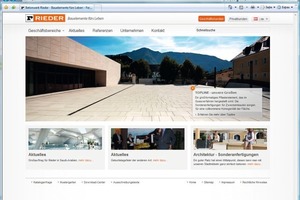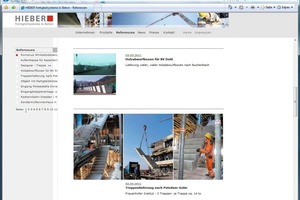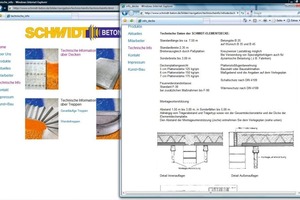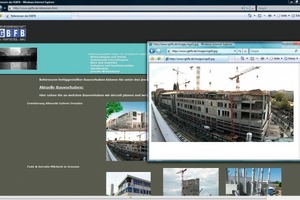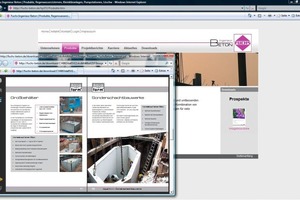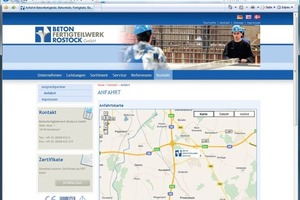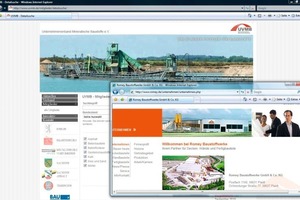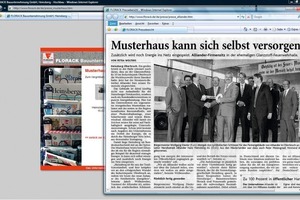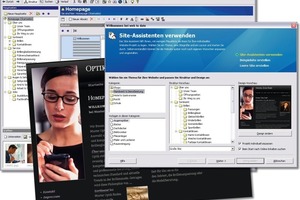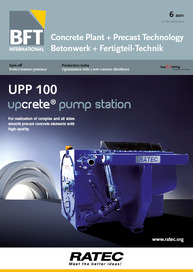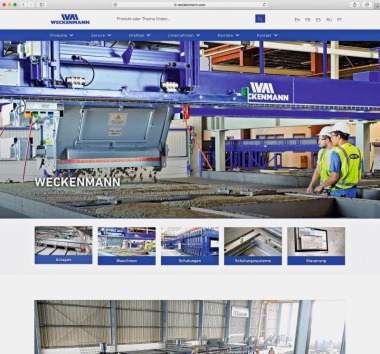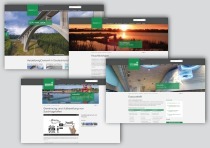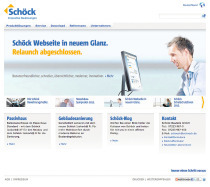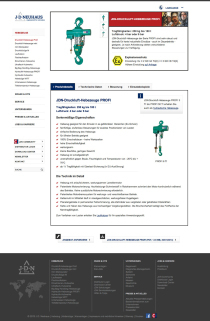Open around the clock
Just a few precast concrete plants make appropriate use of the Internet as a platform to present themselves. How-ever, today an appealing online presence is much more important than ever before. What has to be considered regarding the „digital business card“ and which aspects have to be taken into account regarding technology, designing, content, and law?
Very often, the online presence of a company is clicked off just after a few seconds – company profiles on the Internet are often too dull, too boring, uninteresting and not appealing. However, a professional Internet presence plays a more and more important role for a company. When it comes to presenting oneself as well as the products and services provided in an up-to-date way, conveying information and getting in contact with the appropriate target group, there is hardly any alternative meanwhile. Compared to a printed company brochure, an Internet presence has moreover obvious advantages: it is more current and more flexible; and it is a medium for publication and distribution at the same time. In contrast to the printed matter, the Internet does not know any expiry date. Changes caused by new reference objects or subsidiaries, a new company address, telephone or fax number are carried out just within seconds.
Furthermore, a „virtual“ precast concrete plant is open around the clock: customers, prospective customers and project partners can decide themselves when and where they would like to „drop in“. Who is touched by the content presented may respond by e-mail or contact form without any commitment. Fears of entering unknown places will not occur at all. The synergy effect is another advantage: if an article is published in the local press about the own projects or the own company, referring to the website leaves a professional impression and increases the number of visitors. It is also quite professional to have the own web address printed on business cards, letterheads, advertisements, brochures, or shown on company cars. In addition, websites are even good for analyzing purposes because access statistics provide important data, such as the number of visitors, source address, visitors‘ behavior (route, length of stay, etc.). All these allows to draw conclusions as to the kind of project and services being of interest of whom enabling to optimize the own range of products and/or services offered.
It is quick and easy to get „online“
For creating one‘s own web presence (by the way, the popular term „home page“ indicates just the first „front page“ of a website) a Windows capable PC (at least Pentium 3 processor with 1GB internal memory, Windows XP, and Internet access) is required, which is almost up to date in technical terms. The latter is nowadays available analog using a modem, ISDN or DSL. Analog access using the telephone line is available almost anywhere, however likewise an ISDN access with 56 and/or 64 Kbit/s, it is comparatively slow. People having DSL access can work on the Internet with transfer rates of 1,024 up to 16,000 Kbit/s – that means with an 18 up to 285 times faster speed! The higher the transfer rate the faster a web page is loaded and the faster data can be uploaded and downloaded. It is, however, even more difficult to choose the right Internet service provider. Providers offer technical services, which are necessary for using or providing content and services on the Internet. Roughly defining, providers are differentiated into access and hosting service providers. The former makes sure that you will get access to the Internet by means of a personal user name and a password. The hosting service provider (also called „web host“) in addition allows to run your domain (web address) and offers memory space for a company‘s online presentations. Owing to the large number of providers and the variety of price structures, it is not quite easy to select the most efficient hosting service provider. However, the most crucial criteria are one-off expenses and monthly costs as well as the bandwidth (speed). It is important that the memory capacity on the server of the provider (or you will even lease a server) offered for the web presence is adequate and can be upgraded at any time, and that it is possible to have several e-mail accounts. Furthermore, the provider should offer good and cost-effective support in case of problems and being available at almost anytime needed. (See also provider reviews at www.hosting-tarife.com or www.hostlist.de, etc.)
It has to be considered …
When planning your web presence it is necessary to take all aspects regarding technology, designing, content and law into account:
Choosing the address name (domain name), by which the Internet presence can be called up, is not at all irrelevant. It is quite common to use a description of the activities, e.g., „precast“ or „concrete“ followed by the name of the company, that means, for example, www.precast-mueller.com. As, however, frequently used names are already given away, one has to come up with an idea. Here, such terms prospective customers would search for should be taken into account. If a company, for example, is specialized in staircase elements, a possible domain name will be www.concretestairs-mueller.com. Generally, it can be said: the simpler, the more precise and the more plausible a domain name is, the better.
Special attention should be paid to the front page („home page“). It is decisive for the first impression and contributes to the fact whether a visitor goes on clicking and stays for a longer time. Frequently made mistakes are badly designed home pages with extensive animation and too much graphics without giving any information, that try a visitor‘s patience by long loading times of the pages. It is much better to have a simple, clearly structured front page with just a few pictures, a short introduction, a language selection if applicable and the menu. The front page should immediately reveal that it is about precast concrete components and specifically about company Mueller, for example.
The question about the right menu structure and navigation is a controversial issue. The crucial point is that the visitor gets an idea of a page‘s structure straightaway and knows at any time: Where am I? Where do I come from? Where can I go? Whether to use pull down menus, so-called „tab menus“ or a menu bar along the side is merely a matter of taste. There are always advantages and disadvantages. It is even more significant to give the menu accurate and explicit names that allow to draw a conclusion regarding the content as well as the correct allocation of the submenus. A font type to be read easily is all the same important (e.g., never use a white font on a yellow or light gray background). The pages should be simple and modest, and not being overloaded with neither text nor pictures. Animated design elements are out of the question anyway in view of a sensory and information overload on the Internet. It goes without saying that there should be a search function as well as a so-called „site map“. This is a kind of directory indicating all sites in a (tree) structure. The page layout and/or design have to be in line with the corporate design.
Content
„Company“ and/or „Profile“, „Services“, „References“, „Contact“ and „Map & Directions“ (imperatively including the business hours and a map to print showing how to find the company) belong to the compulsory sections as well as the „Imprint“ (see also paragraph „law“ below). Sections like „News“, „Services“, „Links“ or „Downloads“ are „voluntary exercise“ but may be all the same valuable. If the content is just meant for self-portrayal, the visitor won‘t have much interest in visiting the page once again. If, however, the Internet presence is much more related to the requirements of the customers and partners, and if it provides additional benefit, then new visitors will be attracted too. It is important to provide a service bespoken to the target group, e.g., commented link lists, that are jump labels, referring to other Internet pages, glossaries, etc. It is above all essential always to take the perspective of an imaginary visitor or prospective customer as to find out what he wanted to learn: How long does the company exist? Who are the customers? Will deadlines and costs be met? And last but not least: What does the company make unique compared to others? Who may be able to answer these or other questions convincingly, using short statements of customers, has already achieved a lot.
Graphics – Which kind of data format suits
which purpose?
Apart from photos, many companies like to include graphics, drawings or 3D objects in their online presence. But, which kind of data format suits which purpose? For photos the JPEG format is well established – it allows to display „true colors“ (16.7 million colors) and has a relatively small file size. For imaging simple graphics, however, the GIF format can be used. PNG is another „Internet format“ that combines the advantages of JPEG and GIF (lossless data compression, color depth and transparency). Whereas the standard formats used on the Internet for halftone images (JPEG, GIF, TIF, etc.) work without any additional software programs, vector data (drawings, graphics) require software expansions (so-called „plug-ins“). An advantage of vector data: It is possible to zoom details without any deterioration of quality; the file size is comparatively small. Disadvantages: First of all, the related display program and/or the files have to be loaded (loading time). As the Adobe Reader is widely used, the PDF format has meanwhile become a standard not only for text files but also for drawings and in the meantime even for 3D objects.
Law
Who is presenting his business online, has to disclose the person behind the presence. For this reason, the imprint should contain the following details: name and complete address (street, not PO Box), if applicable the legal form of business (in Germany, e.g., GmbH, AG), telephone, fax number and e-mail address (see also
www.anbieterkennung.de). In order to protect yourself against e-mail spam the @ sign should be replaced by a written (at) put in parentheses – for example, info (at) beton-maier.de – or the e-mail address may be inserted as a graphic. Who wants to state links has to make sure not to reference inadvertently to pages with illegal content. Therefore, it is recommended to state a so-called disclaimer (non-liability clause). It is also important to distinguish external links clearly, to open them on an extra page as well as to check the address from time to time. To copy and insert illegally web design elements, texts, photos or graphics being created and made by third parties leads to problems again and again. In doing so, a copyright is infringed – and this may result in considerable fines. Who is able to write and make photos in an appropriate way, should do everything himself.
Do it yourself or have it done?
Who has some knowledge on computing often feels to be able to create and design the Internet presence himself. That may turn out well, but may also be a complete flop. Experience shows, however, that often the day-to-day business does not leave enough time for not only creating the web presence but also having it become known and above all maintaining the same continuously. This is also the reason for the fact that many companies are constantly „under construction“ on the Internet. If there is no employee available for several days to realize the website and for about 3 – 4 hours per months respectively for maintenance and updating purposes, then an external multimedia expert should be engaged. This capital expenditure will pay off, because an expert knows in detail all tricks of how to improve the screen loading speed of a page, to have the pages appear in the same way on any system and screen, and even to make a page public. It is of great value to have the practical knowledge of a graphic artist, media designer, computer programmer and technician in one person and should therefore be rewarded accordingly. Before consulting an expert, one should be prepared properly, i.e. it is at least necessary to have a concept of the structure and the content. A disadvantage of „outsourcing“ is the fact that for any kind of changes the expert has to be called. Unless a web content management system (WCMS) or modular design system is applied.
WCMS and modular design systems
Web content management systems (WCMS) consequently separate design and content of a website and thus allow updating or expanding of an Internet presence even without any knowledge of website programming. Hence a company does not depend on service providers, saves detailed and clumsy briefings, gains time, and avoids mistakes in the design or user guidance. The WCMS takes independently care of layout and navigation of a website. The modular design systems, containing ready-made templates for various occupation groups and sectors, enable design and maintenance of a homepage even without any programming skills: first of all, the structure and layout of a web presence is stipulated with the aid of formatting templates. If this framework has been „built“, it can be filled with text components and images and the templates can be individually adapted respectively. A certain disadvantage is the partly somewhat limited range of designing potential of WCMS and modular design systems. These disadvantages can, however, can directly be compensated by the possibility to integrate HTML and other content.
To make an Internet presence public
Once the Internet presence is online, work is almost finished. Now it is important to make the address public. Apart from offline advertising (printing the web address on business cards, company cars, etc.), it is possible to register manually – most often free of charge – at other Internet presences (of associations, building portals, etc.) and/or Internet directories or search engines/catalogs, such as Google, Yahoo or Web.de. By functions like „add URL“ or „suggest website“ the own website can be registered online. The assistance of service providers may also be helpful, they register your website at several search engines and catalogs automatically. Optimizing the own web presence in respect of search engines may be particularly efficient. The optimization aims at having the own web presence appear at top positions in the ranking of a search engine. In order to achieve this aim, as many applicable keywords should be mentioned as possible („meta tags“). These are entries on the website, which are not visible for the visitor. The more precise and the more comprehensive a key term (e.g. concrete, precast component, reinforcement, precast concrete, prestressed concrete, etc.) describes the company, services and products, the better. Modern search engines like Google, however, do not follow meta-tags but the content of the page. The less empty words and the more technical content being useful for the visitor is mentioned, the higher the search position is.
The most frequent mistakes...
… of already existing Internet presences are mainly made in respect of design and content. Quite too much different colors, font types and design elements are used, that are not coordinated. Very often, the Internet presence does not have anything in common with the corporate identity (letterhead, brochures, company cars, etc.). Photos used are often too large, too small, being unattractive, out of focus, underexposed or overexposed. Such pages frequently appear as „self made“. The fact that a visitor rather gets an unprofessional impression when looking at a site may quickly have a negative impact on the company. Mistakes are also made again and again in respect of content: in particular, companies operating internationally often just provide a language selection, although this might just as well be incorporated in the actual front page. Texts are very often far too long, using clumsy phrases, and are not target group oriented. On some pages important information is missed, such as „how to find the company“ (possibly including a route planner) or providing a possibility to get in contact with the company either by contact form or e-mail.
Costs and benefits
Who „creates“ his Internet presence himself and does not calculate the own working hours, will get the necessary software tools for at least 500 euros (web and graphics editor, page templates, etc.) for a basic web presence. If a WCMS system is applied, an additional amount of about 500 euros has to be spent on top; but there are online solutions offered which are free of charge. Service providers already offer Internet profiles with simple presentations of the company and the projects for about 1,000 euros to start with. As both the fees and the achievements differ considerably, it is recommended to solicit quotations beforehand and to compare references. Updating is often charged on an hourly basis; therefore a master agreement is reasonable. However, which version a company may chose - either „do-it-your-self“ or „outsourcing“ - it will be a worthwhile investment at all. Indeed, the fact that an Internet presence leads directly to the conclusion of a contract happens quite seldom, as still most orders result from business relationships. However, the acceptance of the Internet is still growing and thus the own web presence becomes a more and more important factor in the keen competition about customers and orders.


